The AMD Radeon R9 Nano Review: The Power of Size
by Ryan Smith on September 10, 2015 8:00 AM ESTOverclocking
Finally, no review of a high-end video card would be complete without a look at overclocking performance.
Of all of the Fiji cards overclocking the R9 Nano is perhaps the easiest and certainly the most unusual. Due to the fact that the card is essentially a 1000MHz Fiji card with a heavy power throttle, the card is already validated for clockspeeds that under load it doesn’t have the available power to reach. As a result while one can crank up the clockspeeds, the card isn’t going to move until you increase the power limit. And even then you are more likely to hit the power cap again than you are to break 1000MHz sustained. So overclocking the GPU is something of an academic affair.
| Radeon R9 Fury/Nano Series Overclocking | |||||
| Ref. R9 Fury X | ASUS R9 Fury | Ref. R9 Nano | |||
| Boost Clock | 1125MHz | 1075MHz | 1075MHz | ||
| Memory Clock | 1Gbps (500MHz DDR) | 1.1Gbps (550MHz DDR) | 1.1Gbps (550MHz DDR) | ||
| Power Limit | 100% | 115% | 135% | ||
| Max Voltage | 1.212v | 1.169v | 1.2v | ||
Overall we were able to overclock our sample to 1075MHz on the GPU and 550MHz (1.1Gbps) on the memory. However load clockspeeds were almost always under 1000MHz even with a generous 35% increase in the power target. Overdrive does allow for a larger increase – up to 50% – but with the R9 Nano featuring a less robust power delivery system designed to push less power than R9 Fury or R9 Fury X, we’re hesitant to increase the limit further without a better idea of what the card can safely sustain for extended periods of time.
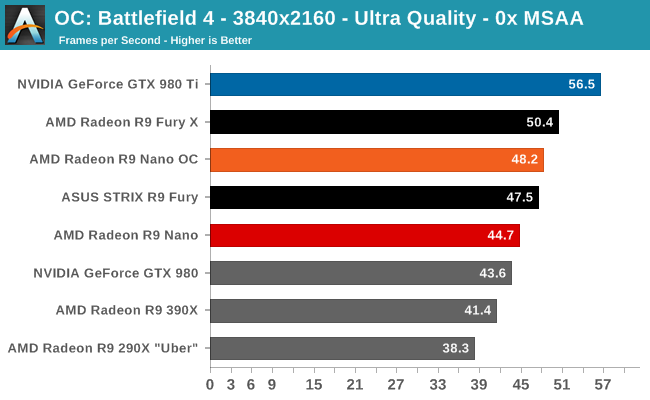

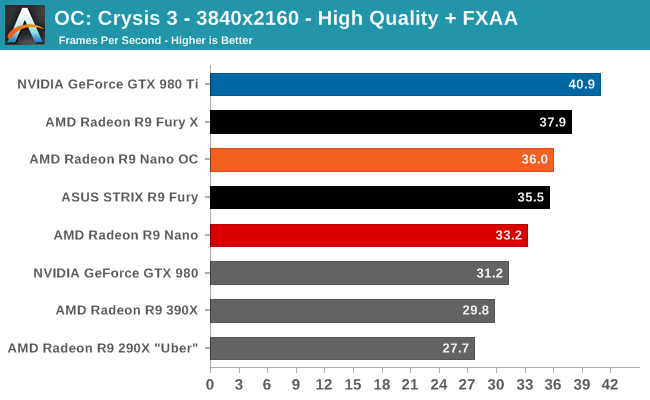
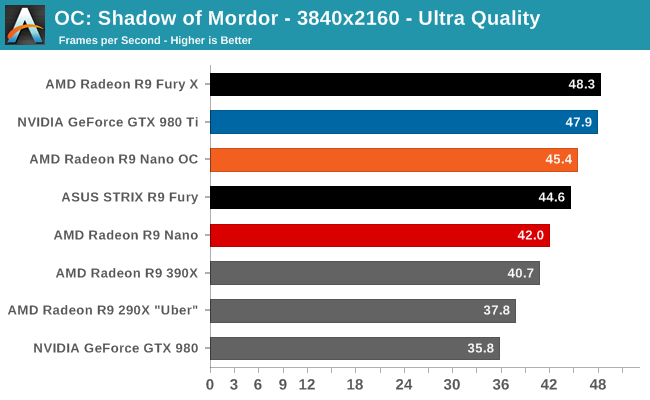
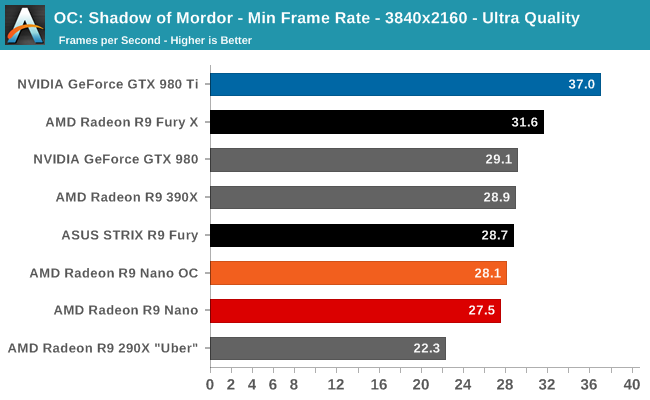
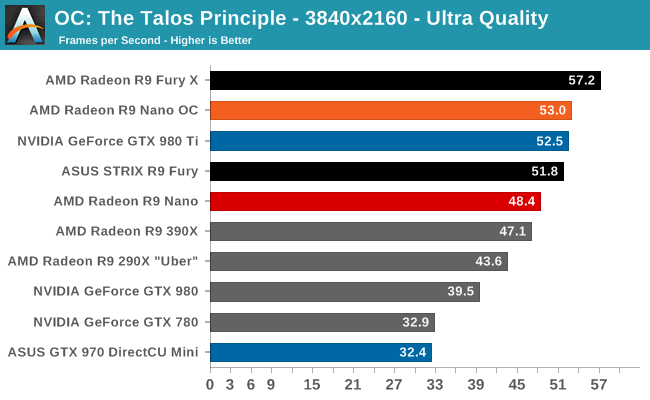
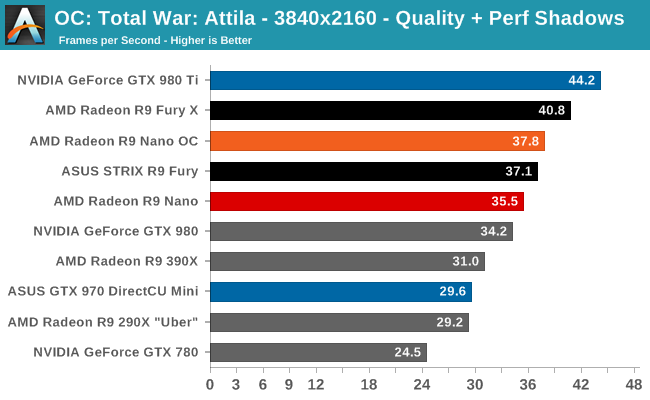
The overall performance gains from overclocking aren’t huge, but at 7-10% they also aren’t too shabby. However since higher clockspeeds quickly ramp up the power requirements due to the higher voltages required, the performance gains won’t be anywhere near the 35% increase in the power limit, despite that we are in fact still power limited.
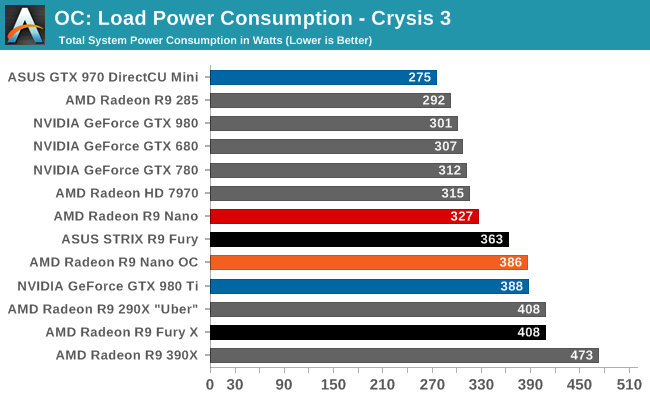
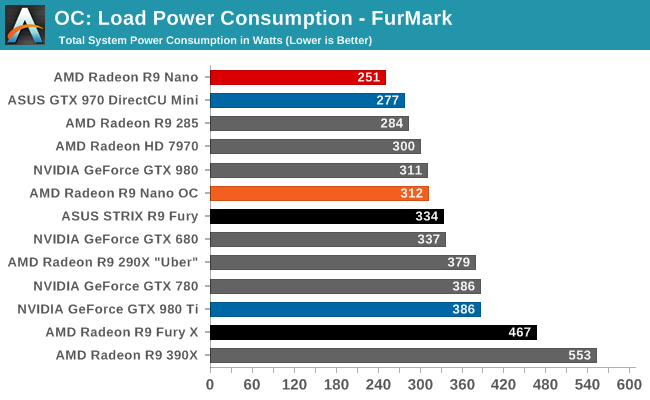
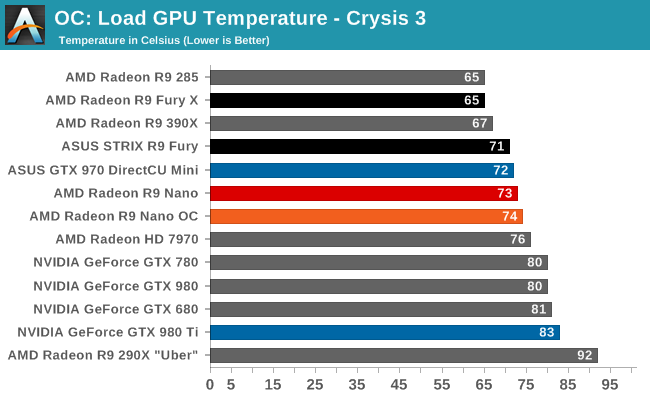
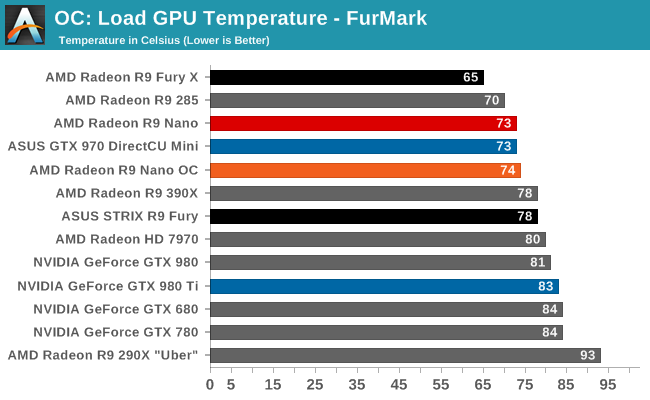
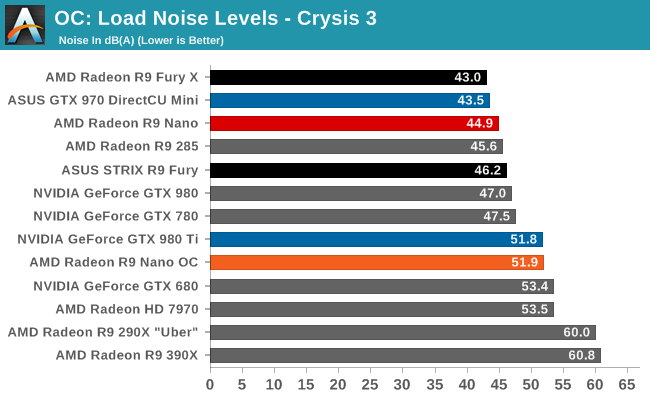
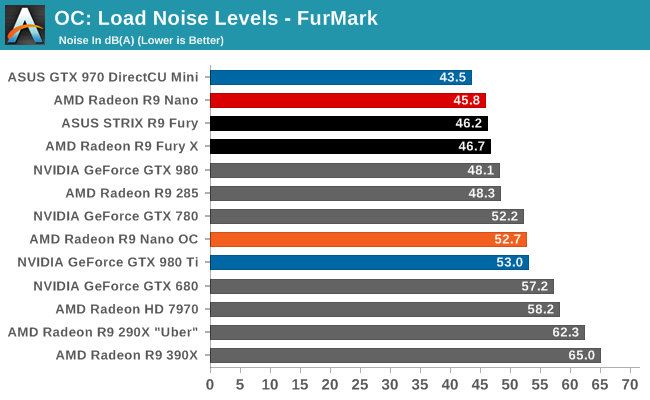
Meanwhile the 35% increase in the power limit has a definite knock-on effect on the cooling system. The R9 Nano’s cooler is able to keep up with the additional load, holding temperatures to 74C, but noise levels are now over 51dB(A). Power consumption at the wall is similarly affected, with the R9 Nano essentially giving up all of its energy efficiency gains in the process.










284 Comments
View All Comments
anubis44 - Thursday, October 8, 2015 - link
"you forgot to include evidence of them lying, or a reason for why they would lie."Are you for real? Evidence of misrepresentation is that the box says '4GB', and you can only practically use 3.5GB of the 4GB in a game, or the performance will tank. How much more evidence do you require?
As for a reason why they would do this? You've got to be joking. $$! That's why. The memory controller they used to make a '4GB' card was cheaper than one that would have run all the memory at full speed. That would likely have pushed the price of the card well above $400, and outside of the targeted dupe market of $350-$400. The cheaper, gimped memory controller also meant that nVidia made more profit per card. They just hoped nobody would catch their use of a gimped memory controller before they'd ripped off tens of thousands of slavishly loyal nVidiots who all mindlessly rushed out to computer stores to plunk down their money. And it worked. Tens of thousands have plunked down their money, and nVidia has posted better than ever earnings. What a surprise.
anubis44 - Thursday, October 8, 2015 - link
HA HA HA! An 'honest' mistake? Give me a break! Are you saying nVidia just didn't realize that the cheap memory controller they saddled the GTX970 had a flaw? Yeah, right. They just didn't know that the last .5GB of memory would be gimped by running it at 1/7 the speed of the other 3.5GB. And of course, the decision to use that cheaper memory controller didn't have ANYTHING to do with padding their already fat profit margins at the expense of their customers. Meanwhile, they have the audacity to print '4GB Ram' on all the boxes. As if nVidia just didn't realize that tens of thousands of nVidiots wouldn't go out and buy the cards for a few months before an independent reviewer finally caught them in the act. nVidia is as guilty as a cat in a goldfish bowl, and if you're going to pretend that this whole fiasco was 'handled admirably' by nVidia, then you must really be a fan of Jen Hsun. Seriously, at least have the self-respect to call a spade a spade and admit that nVidia tried to pull a fast one just to line their pockets and got caught.SolMiester - Thursday, September 10, 2015 - link
Oh please, its already been stated that you have to load up beyond normal use before the .5Gb ram comes into play and for the majority or users at 1080, its doesnt effect them.RussianSensation - Thursday, September 10, 2015 - link
@SolMeiser, 1080P is fine but some gamers who purchased GTX970 did so for their 2560x1440/1600 monitors, in addition to others who bought GTX970 SLI. Also, even if in the majority of games the 3.5GB RAM isn't an issue, it's how NV responded to the situation is what's telling.Kutark - Thursday, September 10, 2015 - link
So, what do you have to say about all the dubious shit AMD said during the pre fiji release? They claimed several times it was the fastest card in the world, when it wasn't, and they KNEW it wasn't.I'm tired of people being inconsistent, if you're going to point out questionable behavior in one company then you have to do it for the other.
silverblue - Friday, September 11, 2015 - link
They could've run benchmarks well before the launch, and then fallen behind once NVIDIA had brought out new drivers, or they could've straight out lied. What I'd like to see is AMD's 4K Gaming Performance Benchmarks bar chart scrutinised for every game to see how far out of reality the results were with the setups that were used, then we can be 100% sure (after all, Fiji is more competitive at 4K than lower resolutions).fuicharles - Friday, September 11, 2015 - link
Not giving a review copies to certain reviewer is worse or the one who create gameworks is worse ?Horza - Thursday, September 10, 2015 - link
Thank you for being the impartial voice of reason Wreckage. I've always enjoyed your measured and balanced approach to assessing the merits of the two big dGPU players. Your attack on Anandtech's credibility holds so much more weight coming from a person with a track record of non-partisan, unbiased viewpoints such as yourself. Thank you again.ingwe - Thursday, September 10, 2015 - link
If you read the final words, I think this is a very fair review. To me it says: "This is better than usual form AMD, but it isn't enough and it is too expensive." Seems accurate and unbiased.bill.rookard - Thursday, September 10, 2015 - link
Actually, I do find it 'enough', it -is- a very good, supremely capable card that comes in at 2/3 of the size with 90% of the performance. Heck, it's faster than the GTX 980. My problem? It is too expensive. I know that prime Fiji chips are in short supply at the moment, but it needs to be about $200 cheaper.If they can get their supply running smoothly and get their yields of the full-fat Fiji up, drop the price to about GTX 980 levels they'd never be able to keep them in stock.